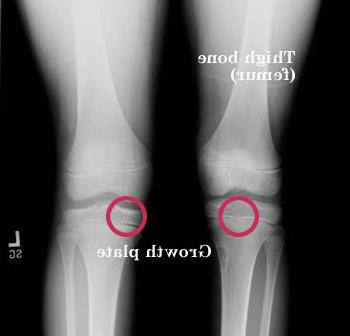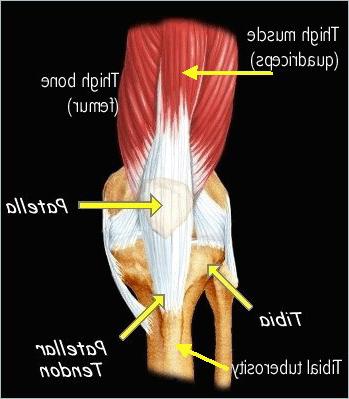Osgood-Schlatter Disease
What You Need to Know
- 奥斯古德-舒拉特病是年幼儿童和仍在成长的青少年膝关节疼痛的常见原因.
- 大多数患有奥斯古德-舒拉特病的儿童只在一个膝盖上发病, but some will develop it in both.
- 年轻运动员最常患奥斯古德-施莱特病, 特别是10到15岁的男孩,他们经常玩游戏或运动,包括跑步和跳跃.
- 奥斯古德-施莱特病的治疗包括减少使病情恶化的活动, icing the painful area, using kneepads or a patellar tendon strap, and anti-inflammatory medication.
- Surgery is rarely used to treat Osgood-Schlatter disease.

What is Osgood-Schlatter disease?
奥斯古德-舒拉特病是一种引起膝关节以下疼痛和肿胀的疾病, 髌腱附着在胫骨顶部的地方, a spot called the tibial tuberosity. 髌骨肌腱延伸至膝盖骨,也可能出现炎症.
奥斯古德-施莱特病最常见于需要大量跳跃和/或跑步的年轻运动员.
What causes Osgood-Schlatter disease?
奥斯古德-舒拉特病是由骨生长板受刺激引起的. 骨头不是在中间生长,而是在关节附近的末端,在一个叫做生长板的地方生长. 当孩子还在生长的时候,这些生长区域是由软骨而不是骨头组成的. The cartilage is never as strong as the bone, 所以高水平的压力会导致生长板开始疼痛和肿胀.

肌腱(髌骨)从膝盖骨向下连接到腿骨前方的生长板(胫骨)。. The thigh muscles (quadriceps) attach to the patella, and when they pull on the patella, tension is placed on the patellar tendon, which then pulls on the tibia in the area of the growth plate. 任何引起腿部反复伸展的动作都可能导致髌骨肌腱与胫骨顶部相连的部位出现压痛. Activities that place stress on the knee — especially squatting, 弯曲和跑上坡(或体育场台阶)-会导致生长板周围的组织受伤和肿胀. Pain is also felt when hitting or bumping the tender area. Kneeling can be very painful.
How is Osgood-Schlatter disease treated?
Osgood-Schlatter disease usually goes away with time and rest. Sports activities that require running, 在压痛和肿胀消退之前,应限制跳跃或其他深屈膝动作. 参加体育运动的运动员可以使用护膝,因为膝盖可能会接触到比赛场地或其他球员. 一些运动员发现在膝盖骨下方佩戴髌骨肌腱带可以帮助减少对胫骨结节的拉力. Ice packs after activity are helpful, and can be applied two or three times per day, 20 to 30 minutes at a time, if necessary. 恢复运动的适当时间取决于人的疼痛耐受力. 运动员不会因为玩游戏而损伤自己的膝盖.

The doctor may also recommend stretching exercises, at home or through formal physical therapy, 增加大腿前后的柔韧性(股四头肌和腘绳肌).
Medicine, 如对乙酰氨基酚或布洛芬等非甾体抗炎药, can be used to help control pain. 如果你的孩子每天需要多剂量的药物治疗,并且疼痛影响了他们的日常活动, resting from the sport should be discussed.
Physical Therapy for Osgood-Schlatter Disease
物理治疗师将首先与患者一起缓解症状, using methods such as ice, heat, 超声波或电刺激,以帮助控制炎症和疼痛.
When pain is under control, therapy shifts focus to flexibility, strength and proprioceptive exercises for all leg muscles. 紧绷的腿筋和股四头肌经常使运动员有受伤的危险, so maintaining flexibility is important.
- 加强小腿和核心的肌肉有助于确保膝盖有良好的肌肉平衡, hip, ankle and core.
- 平衡练习教会一个人意识到身体在空间中的位置,并让不同的腿部肌肉一起工作.
- 体位教育和锻炼可用于解决腿部异常对齐问题. Sometimes, 矫形器(鞋垫)需要帮助纠正平足和敲膝的位置.
Once symptoms have decreased and strength, flexibility and balance have improved, 治疗可能侧重于特定运动的活动和运动模式. 目标是在运动中帮助改善形体,减少膝盖的劳损.
Is surgery ever needed for Osgood-Schlatter disease?
In almost every case, surgery is not necessary. 这是因为软骨生长板最终停止生长,取而代之的是骨头. Bone is stronger than cartilage and less prone to irritation. 疼痛和肿胀消失,因为没有新的生长板受伤. 与奥斯古德-舒拉特病相关的疼痛几乎总是在青少年停止生长时结束.
在极少数情况下,疼痛会在骨骼停止生长后持续存在. 只有当骨碎片没有愈合时,才建议进行手术. 生长中的运动员从不做手术,因为生长板可能会受损.
如果治疗后疼痛和肿胀仍然存在,医生应该定期对运动员进行复查.






